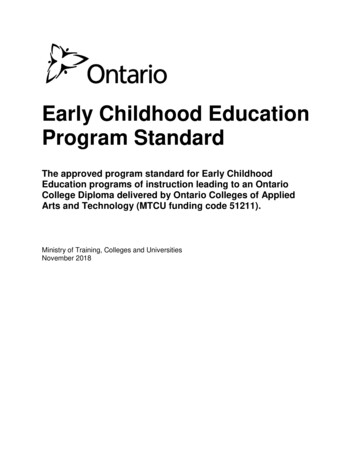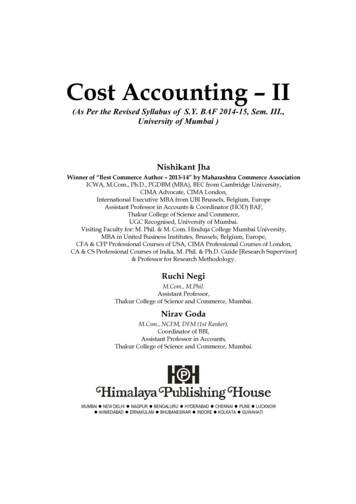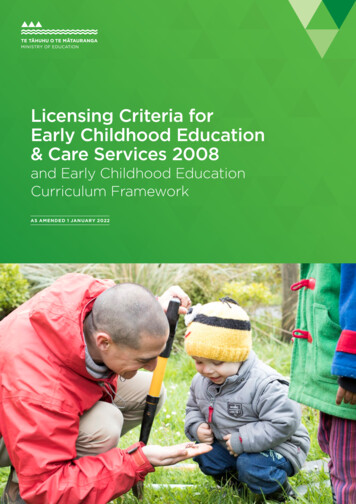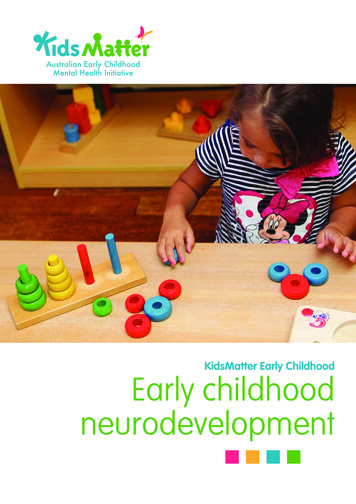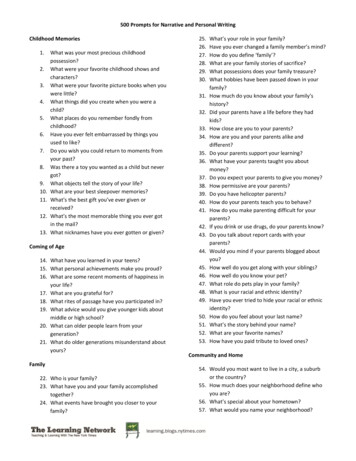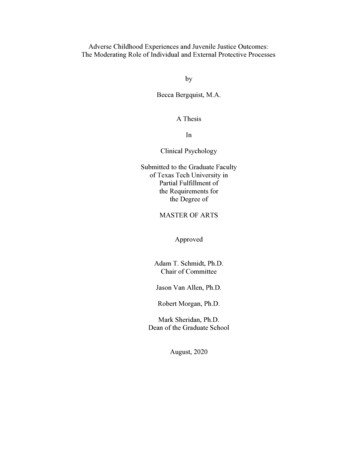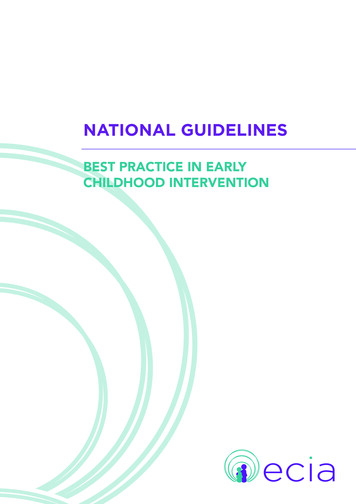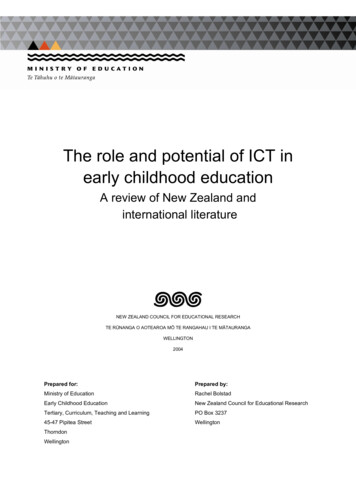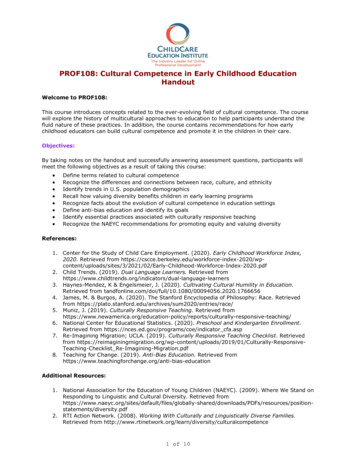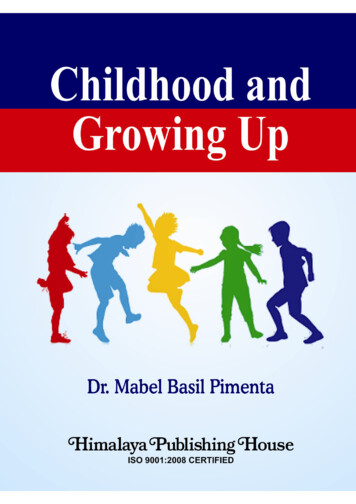
Transcription
ChildhoodandGrowing Up(As Per the Revised Syllabus of F.Y. B.Ed., 2017-18, Semester I,University of Mumbai)Dr. Mabel Basil PimentaAssociate Professor,Pushpanjali College of Education,Papdy, Vasai (W.).ISO 9001:2008 CERTIFIED
AuthorNo part of this publication may be reproduced, stored in a retrieval system, or transmitted in any form or by anymeans, electronic, mechanical, photocopying, recording and/or otherwise without the prior written permission of thepublisher.First Edition: June 2016Second Revised Edition : 2018Published by: Mrs. Meena Pandey for Himalaya Publishing House Pvt. Ltd.,“Ramdoot”, Dr. Bhalerao Marg, Girgaon, Mumbai - 400 004.Phone: 022-23860170, 23863863; Fax: 022-23877178E-mail: himpub@vsnl.com; Website: www.himpub.comBranch Offices:New Delhi: “Pooja Apartments”, 4-B, Murari Lal Street, Ansari Road, Darya Ganj, NewDelhi - 110 002. Phone: 011-23270392, 23278631; Fax: 011-23256286Nagpur: Kundanlal Chandak Industrial Estate, Ghat Road, Nagpur - 440 018.Phone: 0712-2738731, 3296733; Telefax: 0712-2721216Bengaluru: Plot No. 91-33, 2nd Main Road, Seshadripuram, Behind Nataraja Theatre,Bengaluru - 560 020. Phone: 080-41138821; Mobile: 09379847017, 09379847005Hyderabad: No. 3-4-184, Lingampally, Besides Raghavendra Swamy Matham,Kachiguda, Hyderabad - 500 027. Phone: 040-27560041, 27550139Chennai: New No. 48/2, Old No. 28/2, Ground Floor, Sarangapani Street, T. Nagar,Chennai - 600 012. Mobile: 09380460419Pune: First Floor, “Laksha” Apartment, No. 527, Mehunpura, Shaniwarpeth (NearPrabhat Theatre), Pune - 411 030. Phone: 020-24496323, 24496333;Mobile: 09370579333Lucknow: House No. 731, Shekhupura Colony, Near B.D. Convent School, Aliganj,Lucknow - 226 022. Phone: 0522-4012353; Mobile: 09307501549Ahmedabad: 114, “SHAIL”, 1st Floor, Opp. Madhu Sudan House, C.G. Road, NavrangPura, Ahmedabad - 380 009. Phone: 079-26560126; Mobile: 09377088847Ernakulam: 39/176 (New No. 60/251), 1st Floor, Karikkamuri Road, Ernakulam,Kochi - 682 011. Phone: 0484-2378012, 2378016; Mobile: 09387122121Bhubaneswar: Plot No. 214/1342, Budheswari Colony, Behind Durga Mandap,Bhubaneswar - 751 006. Phone: 0674-2575129; Mobile: 09338746007Kolkata: 108/4, Beliaghata Main Road, Near ID Hospital, Opp. SBI Bank,Kolkata - 700 010. Phone: 033-32449649; Mobile: 07439040301DTP by: Sanhita, HansaPrinted at: M/s Sri Sai Art Printer, Hyderabad. On behalf of HPH.
PREFACEThe book is written on ‘Educational Psychology’ titled as ‘Childhood and Growing Up’.Basically, the book is written as per the curriculum of Course 1 of Two Years’ B.Ed. Courseof the University of Mumbai and other Universities in Maharashtra. It will also be useful forthe students of other universities. The book contains a total of eight chapters, which areallotted to different aspects of child growth and development. Social perspectives of growthand development were incorporated in the ‘Two Years’ B.Ed. Course’, hence the need toauthor this was aroused. It is essential to broaden our views pertaining to the growth anddevelopment on a global and national level. Growth and development are no longer merely apsychological process, but has a great sociological impact.The stages of development are the same, but the age is being preponed in terms of theonset of maturity. Adolescence arrives at a tender age of nine or ten. It is due to anintegrated impact of diet, changing lifestyle, gadgets and media. The problems faced by achild are enormous and varied in Indian society due to socio-cultural differences.Adolescents face emotional crises and the effects of it are long lasting. Hence, the parentingstyles play an important role. Parents get a direction, whether they are playing a right role orneed to change their parenting style. All these concepts and issues are discussed inChapters 1, 2 and 3.Many researches are undertaken on child development using various methods andapproaches of psychology. Teachers have to be aware of these research studies to updatethemselves about progress in the subject and issues across the world. Theories aredeveloped by psychologists on social, ecological, cognitive and moral aspects of childdevelopment. Chapters 4 and 5 are allotted to methods, approaches and theories ofdevelopment.In the Indian context, child development is obstructed due to marginalization, diversityand stereotyping. It is necessary to study these concepts and its impact on growth anddevelopment. Many times, a changing family structure becomes a barrier to childdevelopment. Broken families lack attachment and bonding which give rise to trauma inchildhood, may it be child abuse or violence. So, intervention in terms of life skills is the needof the hour in the modern society, which is discussed in Chapter 6.In this modern era, every individual needs to delve deeper and search for ‘self-identity’.They need to be trained to resolve identity crises and overpower the negative impact of it.The child needs to know his own emotions and understand others too. It is possible to trainhim to develop emotional skills and cope up with stress using them. The concepts andpsychological theories related to identity and emotions are described in Chapter 7.It is a challenge before children to establish their identity in this influential world of media.The children need to know the positive and negative impact of media. Their life is full ofcompetitions and pressure from peers. It is necessary to get a clear picture about falsedepictions of children, men and women. Influence of mass media on various factors of thesociety and peer relations, with greater emphasis on its negative influence, are discussed inChapter 8.Dr. Mabel Pimenta
ACKNOWLEDGEMENTSSince 2015, the Two Year B.Ed. course has been implemented in the majority of thestates in India. The syllabi of various courses/subjects have been drafted as per theguidelines of the Curriculum Framework meticulously drawn by the National Council forTeacher Education. The course ‘Childhood and Growing Up’ has been drawn to assist thejourney of future teachers to cope with the learners and their development with reference tothe pluralistic Indian society. I sincerely hope that this book will facilitate this journey.For the successful compilation of this book, I am indebted to many people. First of all,I acknowledge the grace of god in this endeavor. I am very grateful to the ManagementManager Sr. Sushila, Principal, Dr. Mariamma Joseph, my colleagues and librarian ofPushpanjali College of Education for their support. I am grateful to my guide for imbibing inme the spirit of exploration and sustained learning. My husband Basil, daughters, Belindaand Christbel and son Ernest have always been the source of my inspiration.I thank Himalaya Publishing House Pvt. Ltd. for their contribution. I do hope that thebook will be useful to teacher-educators and teacher-trainees to promote understanding ofthe subject.Dr. Mabel Pimenta
SYLLABUSTotal Credits: 6Total Marks: 100Objectives:1. To develop an understanding of the principles of development.2. To develop an understanding of the concept of development within a pluralistic society.3. To develop an appreciation of the child development in the socio-cultural context.4. To apply the knowledge of the methods and approaches of child development.5. To examine the theoretical perspectives of child development.6. To analyze the issues and implications of changing family structure and parenting ongrowing up in a pluralistic society.7.To develop an understanding of looking at one’s own self, feelings and emotions.8. To reflect on how we relate to the world through emotions.MODULE 1: PROCESS OF HUMAN DEVELOPMENT(2 Credits)Unit 1: Growth and Development of a Child(a) Meaning and principles of growth and development and its difference(b) Stages of growth and development (Later Childhood and Adolescence)(c) Role of the school in growth and development of a childUnit 2: Developmental Process(a) Genetic background and development(b) Trends in development (Developmental direction, differentiation and integration and cumulativeinfluence)(c) MaturationUnit 3: Context of Development(a) Child Development as a multidimensional concept within a pluralistic society (Physical,Emotional and Social)(b) Impact of different parenting styles on child development (4)(c) Child development in a socio-cultural context: Interplay of poverty, caste, gender and tribalcommunitiesMODULE 2: PERSPECTIVES OF HUMAN DEVELOPMENTUnit 4: Methods and Approaches of Studying Human Development(a) Methods: Observation (Participatory and Non-participatory)(b) Experimental and Clinical(c) Approaches: Cross-sectional, Cross-cultural and Longitudinal.(2 Credits)
Unit 5: Theoretical Perspectives(a) Piaget’s theory of cognitive development(b) Kohlberg’s and Errickson’s theory(c) Urie Bronfenbrenner theory on ecological systemUnit 6: Self and Emotions(a) Formation of self (Self-concept, Self-esteem and Self-efficacy)(b) Emotions: Goleman’s theory of emotional intelligence(c) Identity crisis – Marcian theoryMODULE 3: INTERNAL ASSESSMENTSr. No.Particulars(2 Credits)Marks1Task/Assignment/Activity for each module held in thesemester ( 2 10)202One periodical class test held in the given Semester153One Essay test held in the given Semester05Total40Any two of the following tasks:(a) Task (any two) Case study of any school which has a positive impact on the overall growth anddevelopment of its students. Observe an adolescent and conduct a case study on his overall development. Present the biography of any one psychologists using creative techniques.(b) Psychological Tests (any one) Emotional Intelligence test Test on Self-esteem Test on Self-efficacy
CONTENTSMODULE 1: PRINCIPLES OF DEVELOPMENT1. Human Growth and Development1.1 Meaning of Growth1.2 Characteristics of Growth1.3 Meaning of Development1.4 Characteristics of Development1.5 Difference between Growth and Development1.6 Implications of Growth and Development1.7 Principles of Growth and Development1.8 Stages of Development1.8.1 Infancy and Toddlerhood1.8.2 Early Childhood1.8.3 Later Childhood1.8.4 Adolescence1.9 Current Issues Pertaining to Adolescence2. Process of Development2.1 Genetic Background and Development2.1.1 Genetic Background2.1.2 Meaning of Heredity2.1.3 Impact of Genetic Factors on Child Development2.1.4 Gene-Environment Interactions2.1.5 Impact of Heredity and Environment on Development2.2 Trends in Development2.2.1 Patterns and Classification of Development2.2.2 Developmental Direction2.2.3 Differentiation and Integration-Increase in Complexity2.2.4 Cumulative Influence2.3 Maturation and Learning2.3.1 Some Definitions of Learning2.3.2 Concept of Maturation2.3.3 Characteristics of Maturation2.3.4 Importance of Maturation for Learning2.3.5 Maturation and Learning2.3.6 Educational Implications of Maturation1 – 2425 – 38
MODULE 2: FUNDAMENTALS OF DEVELOPMENT3. Context of Development39 – 573.1 Child Development as a Multidimensional Concept within a Pluralistic Society(Physical, Emotional and Social)3.1.1 Pluralistic Society3.1.2 Child Development in a Pluralistic Society3.1.3 Children’s Development is Multidimensional3.2 Impact of Different Parenting Styles on Child Development3.2.1 Definitions and Meaning of Parenting Styles3.2.2 Choosing Parenting Style – Factors3.2.3 Types of Parenting Styles3.2.3.1 Authoritarian Parenting Style3.2.3.2 Authoritative Parenting Style3.2.3.3 Permissive Parenting Style3.2.3.4 Uninvolved Parenting Style3.3 Child Development in Socio-cultural Context: Interplay of Poverty, Caste, Gender andTribal Communities3.3.1 Child Development and Poverty3.3.2 Child Development and Caste3.3.3 Child Development and Gender3.3.4 Child Development and Tribal Communities4. Methods and Approaches of Studying Child Development4.1 Methods of Studying Child Development4.1.1 Introspection Method4.1.2 Observation Method4.1.2.1 Types of Observation4.1.3 Clinical Method4.1.4 Experimental Method4.2 Approaches to Study Child Development4.2.1 Cross-sectional Approach4.2.2 Cross-cultural Approach4.2.3 Longitudinal Approach58 – 81MODULE 3: PERSPECTIVES OF DEVELOPMENT INPSYCHO-SOCIAL CONTEXT5. Theoretical Perspectives of Child Development5.1 Social Cognition: The Social Formation of the Mind-Vygotsky5.1.1 The Role of Socio-cultural Interaction in Cognitive Development82 – 101
5.25.35.45.55.65.1.2 Concepts and Principles of Cognitive Development5.1.3 Educational Implications of Theory of Social Cognition by VygotskyEcological Systems: Urie Bronfenbrenner5.2.1 The Five Environmental Systems5.2.2 Educational Implications of Theory of Urie BronfenbrennerCognitive Constructivism: Piaget’s Theory of Cognitive Development5.3.1 Key Concepts of Piageterian Theory5.3.2 Stages of Cognitive Development5.3.3 Educational Importance of Piaget’s Theory of Cognitive DevelopmentComparison of Vygotsky’s and Piaget’s Theories of Cognitive DevelopmentMoral: Kohlberg’s Theory of Moral Development5.5.1 Moral Dilemmas given by Kohlberg5.5.2 Stages of Moral Development as per Theory of Kohlberg5.5.3 Educational Implications of Kohlberg’s TheoryErickson’s Theory of Psycho-social Development6. Growing Up in a Pluralistic Context102 – 1196.1 Growing Up in the Context of:6.1.1 Marginalization6.1.2 Growing up in the Context of Diversity6.1.3 Growing up in the Context of Stereotyping6.2 Issues and Implications of Changing Family Structure and Parenting on Growing Upwith Respect to:6.2.1 Meaning of Attachment and Bonding6.2.2 Experiences of Trauma in Childhood-Child Abuse, Violence, Death of aParent6.3 Interventions for Life Skills in the Areas of-Communication, and Coping withEmotions and Stress Interpersonal Skills6.3.1 Communication6.3.2 Interpersonal Skills6.3.3 Coping with Emotions and StressMODULE 4: DEVELOPMENT OF IDENTITY7. Understand Self and Emotions7.1 Formation of Self based: Self-concept, self-esteem, self-efficacy7.1.1 Self-concept7.1.2 Self-esteem7.1.3 Self-efficacy7.2 Study of Emotions: Daniel Goleman’s Theory of Emotional Intelligence7.3 Identity Crises: James Marcia’s Theory of Identity Crisis120 – 138
8. Establishing Identity in a Real World139 – 1498.1 Influence of Media: Depiction of Children, and Men and Women onTelevision and Cinema, Social Networking8.1.1 How do Media Depict Children and Teens?8.1.2 How do Media Depict Men and Women?8.1.3 How do Media Depict Gender?8.1.4 Role of a Teacher in Establishing Identity with Respect to the Media8.2 Peer Relations: Competitions, Cooperation and Peer Pressure8.2.1 Social Interdependence Theory-by D.Johnson & R.Johnson (1989)8.2.2 Meaning of Peer Pressure8.2.3 Teachers’ Role in Establishing Identity with Respect to Peer PressureQuestion Paper150
Module 1 : Principles of Development1ChapterHuman GrowthandDevelopmentObjectives To identify the importance of growth and development To define growth and development To differentiate between growth and development To identify the stages of development To describe the aspects of each stage of development To describe the importance of stages of developmentStructure1.1 Meaning of Growth1.2 Characteristics of Growth1.3 Meaning of Development1.4 Characteristics of Development1.5 Difference between Growth and Development1.6 Implications of Growth and Development1.7 Principles of Growth and Development1.8 Stages of Development1.8.1 Infancy and Toddlerhood1.8.2 Early Childhood1.8.3 Later Childhood1.8.4 Adolescence1.9 Current Issues Pertaining to Adolescence
2Childhood and Growing UpWhen we look at a bonsai tree, what do we notice? Sometimes we come across overgrown treesthat do not bear any fruits, but what do we notice in the case of the bonsai? So in one exampledevelopment is prominent, on the other hand, growth is significant in the other example. Let usunderstand human growth and development and also the difference between the two.The terms growth and development are used interchangeably. The meaning of the two overlapmany times. But there are some basic differences in the two terms. The difference between growth anddevelopment is given below:1.1 MEANING OF GROWTHThe term growth denotes a net increase in the size, or mass of the tissue. It is largely attributed tothe multiplication of cells and increase in the intracellular substance. The term growth implies anincrease in size. When a body or any of its parts is described as having grown, it usually means that ithas become large and heavy. It is thus that we speak of the growth of arms, brain, muscles or the bodyin general. Growth means an increase or addition in size, height, length or weight and can be measured.It is due to cell division. The Encyclopedia Britannica defines “growth” as an increase in the size or the amount ofan entity. The word growth is used for all those structural and physiological changes thattake place within individuals during the process of maturation.For example, the increase in weight, height, length of limbs, limbs and size different organs iscalled growth. It is a biological process and continues from birth to adulthood. When a child eats food,it becomes a part of his body. During this time new cells are produced, which results in physicalincrease. This physical increase is called growth. According to Hurlock (1959): “Growth is change in size, in proportion, the disappearanceof the old features and acquisition of new ones”, i.e., growth in height, falling of milk teethand acquisition of permanent teeth. According to Crow and Crow (1962): “Growth refers to structural and physiologicalchanges.” It means any change in size and proportion of limbs indicates structural change,whereas an increase in the internal organs are physiological changes.1.2 CHARACTERISTICS OF GROWTH Changes in the quantitative aspects come into the domain of growth. Growth is used inpurely physical terms; it generally refers to change in size, length, height, weight and shapeof body organs like the brain, etc. of an individual. Growth is one of the aspects of the developmental processes. Growth describes the changeswhich take place in a particular aspect of the body and behaviour of an organism. Growth does not continue throughout life, it stops when maturity has been attained. Thechanges produced by growth may be quantified. Growth may or may not bring development. A child may grow (in terms of weight) bybecoming fat, but his growth may not bring any functional improvement (qualitative change)or development.
Human Growth and Development31.3 MEANING OF DEVELOPMENTDevelopment means a change in shape, form or structure so as to improve its working orfunctioning. Human development is the progression and regression that occur within human beingsover the life span. Development implies certain qualitative changes or changes in character leading tomaturity of improvement in functioning. For example, when the muscles of the legs become strong, achild begins to crawl, then stand, and then starts walking. So, this crawling, standing and walking iscalled development.Children grow, but they also develop by undergoing certain changes, which equip them for betterwork. Development is a progressive change the child undergoes, which increases the physical, social,mental and emotional capacities of the child. In the early stages of life these changes are constructive.After middle age, there are destructive changes in the body, which lead to old age. The Encyclopedia Britannica defined the word ‘development’ as the progressive change insize, shape, and function during the life of an organism by which its genetic potential(genotype) is translated into functioning adult systems (phenotype). This means thatdevelopment includes the increase not only in the size, but also in the function of an organ. According to J.E. Anderson (1950), “Development is concerned with growth as well asthose changes in behaviour which results from environmental situations”. According to Hurlock (1959), “Development means a progressive series of changes thatoccur in an orderly, predictable pattern as a result of maturation and experience.” According to Crow and Crow (1962), “Development is concerned with growth as well asthose changes in behaviour which results from environmental situations”. According to Liebert, Poulos and Marmor (1979), “Development refers to a process ofchange in growth and capability over time, as a function of both mature and interaction withthe environment. Thus, the development includes Growth, Capability, Maturation andInteraction with the environment”.1.4 CHARACTERISTICS OF DEVELOPMENT Changes in the child that occur over time. The changes follow an orderly pattern that movestoward greater complexity and enhances survival. Development implies overall changes in shape, form or structure, resulting in improvedworking or functioning. It indicates the changes in the quality or character rather than in quantitative aspects. Development is a wide and comprehensive term. It refers to overall changes in theindividual. Growth is one of its aspects. It can be observed by maturing behaviour. Development describes the changes in the organism as a whole and does not list changes inparts. Development is a continuous and lifelong process. Development implies improvement in functioning and behaviour and hence bringsqualitative changes.
4Childhood and Growing Up Development is also possible without growth as we see in the cases of some children. Theydo not gain in terms of height, weight or size, but they do experience functionalimprovement or development in physical, social, emotional or intellectual aspects.Development deals with all the aspects of personality and has a vast scope.These two terms have different meaning and characteristics, but they are interdependent. Growthcannot be separated from development and development is comprised of growth. Thus, limited growthhampers development, whereas balanced growth promotes development.1.5 DIFFERENCE BETWEEN GROWTH AND yAge limitInclusivenessScopeGrowthDevelopmentNet increase in size due to multiplicationof cellsIncrease in height, weightGrowth of limbs and organsMore emphasis is on the physical aspect.Physical development is referred to asgrowthIt is quantitative in nature, someasurable in various unitsGrowth is limited up to a certain age,i.e., 17-18 yearsIt stops at maturityGrowth does not include development.But it has an impact on development,i.e., due to adequate growth in heightand weight a child gains confidenceGrowth may or may not bringdevelopment, i.e., ObesityChange in body structure resulting intofunctioningThe child develops skills in writing, reading,drawing, communicating, etc.It includes physical, cognitive, emotional,social and moral aspectsQualitative in nature. It cannot be measured,but observed in terms of implicationsIt is throughout human life, from birththrough old ageDevelopment continues through experiencesDevelopment is a broad term. Growth is oneaspect of development. It is an integratedconcept comprised of many aspects.Development is possible without growth, i.e.,a person may not grow physically, butfunctional progress is observed1.6 IMPLICATIONS OF GROWTH AND DEVELOPMENTNutrition: Implementation of mid day meals in schools needs to be done as per the guidelines ofthe government. The quality of food grains and other food items need to be maintained by the school.The teachers need to make sure the students are benefitted by the midday meals. There is increasingevidence that nutrition interventions in school age children can have a positive effect on cognitivefunction, learning and classroom behaviour. Guide the students about the importance of balanced dietand intake of calories as per the age group. Teachers can alert them about the ill effects ofconsumption of fast food and unhygienic food from roadside vendors.Medical checkups: Medical checkups can be regularly organized in the school by availing ofsponsorships from organizations like Lion’s Club, Rotary Club, etc. Early interventions can help in thediagnosis of various diseases and helps the children with prescription of supplementary vitamins andminerals, which act as a precaution for further prolonged illnesses.
Human Growth and Development5Organization of sports: Organize a sports competition among school houses and at inter-schoollevel. The school’s role is to teach human growth and development and to facilitate communicationbetween home and school. The school needs to provide facilities for sports during breaks and periodsof physical education. Various school teams for outdoor games – football, cricket, kho-kho, kabbadi,etc. can be organized which can participate in intra- and inter-school competitions.Organization of physical activities: Physical activities promote health and fitness. It buildshealthy bones and muscles. It also reduces the risk of developing obesity and risk factors for diseasessuch as diabetes and heart disease. It reduces the symptoms of anxiety and depression. It can positivelyaffect concentration, memory, and classroom behaviour. Activities that can be part of unstructuredplay are climbing trees, playing tug-of-war, etc. Activities that can be structured are push-ups, pull-ups,working with resistance bands and lifting weights. Make use of low or no-cost resources like publicparks, community fields, courts and recreation areas. Replace inactivity with activity wheneverpossible. Example: walk or bike to school instead of riding a car or scooter.Social programmes: Social service camps, interaction with children in orphanages, visits tohome for the aged and cleanliness drives can be organized to promote socialization of children.Methods of teaching, learning, like cooperative learning, group projects, game techniques,brainstorming, etc. help students to gel and interact with the groupCounselling cell: A counselor guides the students and helps solve emotional problems likedepression, anxiety, nervousness, etc. to ensure emotional development. Behavioural problems likeaggressiveness, lying, bullying, stealing and truancy can be tackled by the counselors and teachers.Inclusive attitude towards handicapped and impaired students can be developed among the regularstudents due to the efforts of the counselling cell.1.7 PRINCIPLES OF GROWTH AND DEVELOPMENTChanges that take place in the individual due to the process of growth and development followcertain well-defined principles. These principles are the principles of growth and development whichare described below:1. Development continues throughout the individual's lifespan: Development is continuousfrom womb to tomb and never ceases. One stage of development lays the foundation for thenext stage of development. For example, in motor development, there is a predictablesequence of developments that occur before walking.2. There are individual rates of growth and development: Gender-wise as well assituational differences are observed in growth and development. Some children will walk atten months while others walk a few months older at eighteen months of age. Some childrenare more active while others are more passive. This does not mean that the passive child willbe less intelligent as an adult.3. Rate of growth and development is not uniform: The rate of growth and development inthe first few months of infancy is very rapid and it is slowed down in later years of infancy.At later adolescent stage, sudden spurt in the rate of growth and development is observed fora short period. There are periods of acceleration and decelerated growth suggests that
6Childhood and Growing Updifferent body systems grow at different rates. For instance, the nervous system is highlydeveloped during infancy.4. Development proceeds from the simple to the complex: All the aspects of developmentbegin with simple activities and move towards complex ones. For example, learningrelationships between things on the basis of similarities and differences, or classification, isan important ability in cognitive development. Here, the child begins with similarityfollowed by differences. Initially, child learns simple classification and then multipleclassifications.5. Development proceeds from general to specific: In all the stages of development, specificactivity is followed by general activity. If you give a toy to small baby, she will move thewhole body to grasp it. Initially, the child reacts to the stimuli with the whole body andgradually learns to give specific responses. In motor development, the infant will be able tograsp an object with the whole hand before using only the thumb and forefinger. When4-year-old writes, he uses his entire arm and gradually only the thumb and forefinger.6. Development occurs in a cephalocaudal and a proximodistal progression: The child’spattern of growth is in a head-to-toe direction, or cephalocaudal, and in an inward tooutward pattern called proximodistal. This means that the spinal cord develops before outerparts of the body. The child’s arms develop before the hands and the hands and feet developbefore the fingers and toes. For example, a child waving good-bye uses entire arm, thenhand and finally only fingers.7. The acquisition of gross motor skill precedes the development of fine motor skills: Bothprocesses occur in a cephalocaudal fashion. Head control preceding arm and hand controlfollowed by leg and foot control.8. Development is a product of contribution of hereditypossible to indicate exactly in what proportion heredity anddevelopment of an individual. Growth and development isbetween heredity and development. Thus, there is interactionsocial and psychological environment.and environment: It is notenvironment contribute to thedue to continuous interactionamong inherited and physical,9. Each change is the culmination of prior growth and experience: Development is a resultof interaction of maturation and learning. Learning denotes the changes in behaviour due totraining or experience. It states that simple skil
Dr. Mabel Pimenta. SYLLABUS Total Credits: 6 Total Marks: 100 Objectives: 1. To develop an understanding of the principles of development. 2. To develop an understanding of the concept of development within a pluralistic society. 3. To develop an appreciation of the child development in the socio-cultural context.
